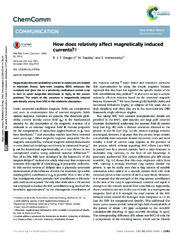| dc.contributor.author | Berger, Raphael Johann Friedrich | |
| dc.contributor.author | Repisky, Michal | |
| dc.contributor.author | Komorovsky, Stanislav | |
| dc.date.accessioned | 2016-03-21T10:40:43Z | |
| dc.date.available | 2016-03-21T10:40:43Z | |
| dc.date.issued | 2015-07-23 | |
| dc.description.abstract | Magnetically induced probability currents in molecules are studied
in relativistic theory. Spin–orbit coupling (SOC) enhances the
curvature and gives rise to a previously unobserved current cusp
in AuH or small bulge-like distortions in HgH2 at the proton
positions. The origin of this curvature is magnetically induced
spin-density arising from SOC in the relativistic description. | en_US |
| dc.description | Published version. Source at <a href=http://doi.org/10.1039/c5cc05732a>http://doi.org/10.1039/c5cc05732a</a>. | en_US |
| dc.identifier.citation | Chemical Communications 2015, 51(73):13961-13963 | en_US |
| dc.identifier.cristinID | FRIDAID 1286476 | |
| dc.identifier.doi | 10.1039/c5cc05732a | |
| dc.identifier.issn | 1364-548X | |
| dc.identifier.uri | https://hdl.handle.net/10037/9048 | |
| dc.identifier.urn | URN:NBN:no-uit_munin_8611 | |
| dc.language.iso | eng | en_US |
| dc.publisher | Royal Society of Chemistry | en_US |
| dc.relation.projectID | Norges forskningsråd: 179568 | en_US |
| dc.rights.accessRights | openAccess | |
| dc.subject | VDP::Matematikk og Naturvitenskap: 400::Kjemi: 440 | en_US |
| dc.subject | VDP::Mathematics and natural science: 400::Chemistry: 440 | en_US |
| dc.title | How does relativity affect magnetically induced currents? | en_US |
| dc.type | Journal article | en_US |
| dc.type | Tidsskriftartikkel | en_US |
| dc.type | Peer reviewed | en_US |


 English
English norsk
norsk